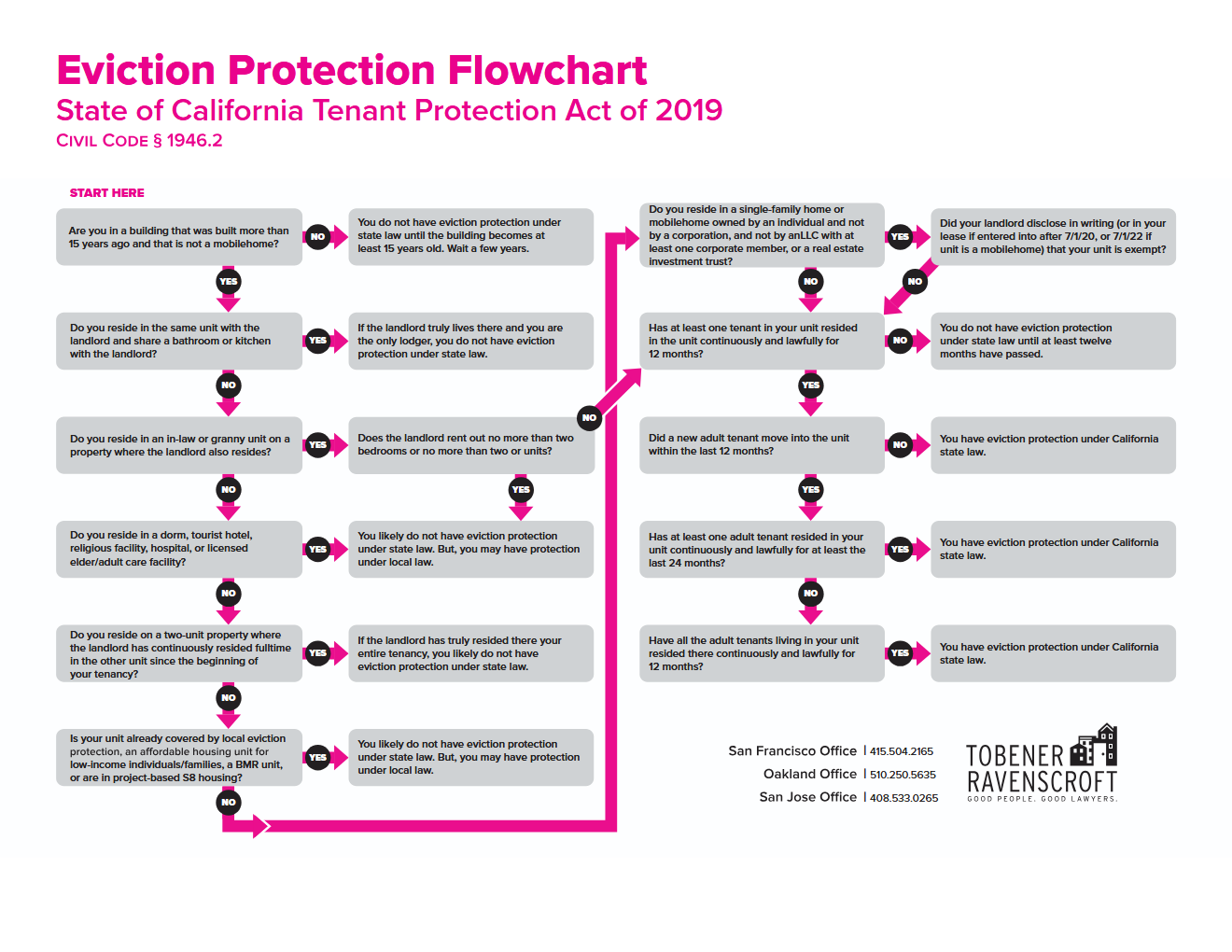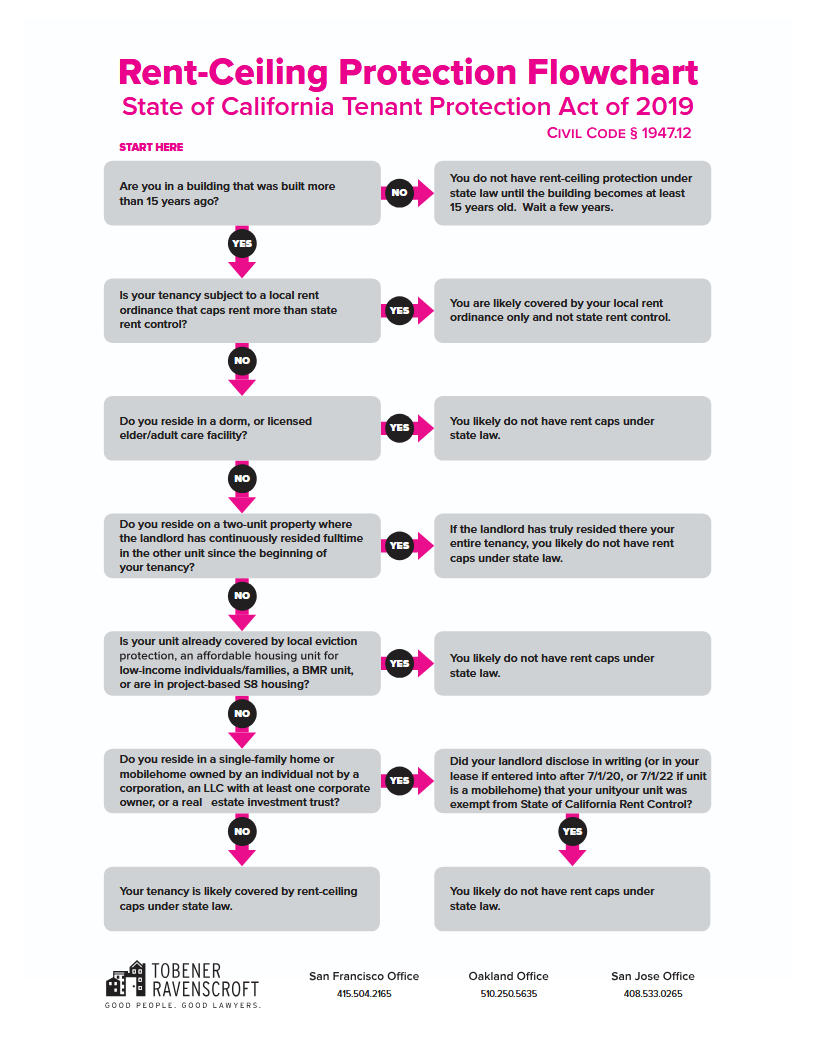Tenant Lawyers For San Jose Renters

20
Years of Service
$100M
Recovered
99%
Success Rate
1000+
Five-star Reviews
Tobener Ravenscroft LLP is a full-service tenant rights law firm with offices in Northern and Southern California. We are proud to only represent tenants, never landlords, in San Jose and the surrounding areas. Our services include fighting landlord harassment, wrongful eviction, and habitability. We’ve served thousands of California tenants and have a combined 500+ 5-star reviews on Yelp and Google Business. Find contact details for our San Jose office below.

Contact Us
Tobener Ravenscroft LLP
111 N Market St Suite 300, San Jose, CA 95113
408-533-0265
Evicted?
A new California law allows those evicted since march of 2019 to be eligible for financial compensation.
State Of California Tenant Protection Act Of 2019
There are two protections under the new state of California tenant protection act of 2019: eviction protection and rent-ceiling protection. Under eviction protection, a landlord can only evict a tenant for fifteen reasons, or just causes. The rent-ceiling protection caps rent increases to five percent per year, plus the annual percent change in the annual cost of living adjustment. Determining whether your unit and tenancy are covered by just-cause eviction protection and rent caps is a very complicated analysis.

Do I Have Eviction Protection Under California’s Tenant Protection Act?
Determining whether you have just-cause eviction protection is a two-step analysis. First, you must determine whether your unit qualifies. Second, you must determine whether you have met the length-of-tenancy requirement. Below, we explain how to determine whether you have eviction protection.

Step One: Is My Unit The Type That Is Covered By State Of California Eviction Protection?
All units in California that have certificates of occupancy that are fifteen years or older have eviction protection, except the following:
- Single-family homes and condominiums owned by an individual and not a corporation, an LLC owned by a corporation, or a real estate investment trust, but only if the owner of the single-family home or condominium discloses in the lease that the unit is exempt.
- Units where one tenant lives with a landlord and shares a bathroom or kitchen with the landlord.
- Single-family homes with in-law units, accessory-dwelling units, or granny units, where the landlord occupies the single-family home and rents out no more than two units or bedrooms.
- Duplexes where the landlord has continuously occupied one of the units since the beginning of the tenancy as the owner’s principal place of residency.
- Dorms owned and operated by a school.
- Hotels rooms where maid service, mail or other room services are provided.
- Housing accommodations in a nonprofit hospital, religious facility, extended care facility, or licensed elder care or adult care facility.
- Affordable housing units, BMR units, and Section 8 units, including Section 8 voucher units.
- Units covered by local rent control, even if the local ordinance has weaker eviction protection.
- Mobile homes
Fight Back!
Step Two: Is My Specific Tenancy Covered By State Of California Just-Cause Eviction Protection?
A tenant or group of tenants who have continuously and lawfully occupied a unit for twelve months from the beginning of the tenancy have eviction protection. However, if another adult tenant is added to the unit after the beginning of the lease, the household does not have eviction protection until either (1) all adult tenants have continuously and lawfully resided in the unit for twelve or more months, or (2) at least one adult tenant in the unit has continuously and lawfully resided in the unit for twenty-four months.
What Are The Just Causes For Eviction Under The State Of California Rent Control?
There are fifteen just causes under the Tenant Protection Act of 2019:
- Failure to pay rent.
- Breach of a material term of a lease that continues after a written notice of the right to cure. The written notice must provide at least three days to cure. If the tenant does not cure, then a non-curable notice of termination may be served.
- Maintaining, committing, or permitting a nuisance.
- Committing waste.
- Failure to sign a lease with similar terms after the expiration of a lease.
- Criminal activity on the property, or criminal activity or criminal threat directed at an owner or manager of the property.
- Assigning and subletting in violation of the lease.
- Refusal to provide the owner access to the unit.
- Using the premises for an illegal purpose.
- Failure of a licensee, agent or employee of the landlord to vacate after termination of the relationship.
- Failure of a tenant to deliver possession after the tenant gives a notice to move out or after the landlord and tenant agree in writing that the tenant will vacate.
- Owner or relative move in only where the original lease or a new lease allows for an owner or relative to move in. The eviction must be done by an owner or the owner’s spouse, domestic partner, children, grandchildren, parents, or grandparents. The original lease or new lease must reserve the right to move in an owner or the owner’s spouse, domestic partner, children, grandchildren, parents, or grandparents.
- Withdrawal of the unit from the rental market.
- Where a city or county agency requires the unit to be vacated due to uninhabitable conditions.
- Intent to demolish or substantially remodel a unit. “Substantially remodel” means the replacement or substantial modification of any structural, electrical, plumbing or mechanical system that requires a permit, or the abatement of hazardous material, including lead, mold or asbestos that cannot be reasonably accomplished in a safe manner with the tenant in the unit and that requires the tenant to vacate for more than thirty days. Cosmetic improvements alone, including painting, decorating, and minor repairs, do not qualify, nor does any work that can be done safely with the tenant in the unit.
Am I Entitled To Relocation Payments When I Am Evicted Under State Of California Rent Control?
A landlord who evicts a tenant for an owner move in, a relative move in, demolition, substantial remodel, pursuant to city or county abatement, or to withdraw the unit from the rental market, must provide one of the following forms of tenant assistance at the landlord’s discretion:
- Provide one month’s rent within fifteen days of serving the eviction notice; or
- Waive the final month’s rent.
The eviction notice must inform the tenant of the right to relocation assistance. If the tenant does not vacate at the expiration of the notice, the landlord may recover the relocation assistance as damages. A landlord is entitled to credit the relocation against relocation required by a different statute or ordinance.
Can I Waive My Rights To The Protections Under State Of California Rent Control?
A tenant cannot waive their rights under the Tenant Protection Act of 2019. Any waiver of rights by a tenant is void against public policy.
Does My Lease Have To Say I Am Protected Under State Of California Rent Control?
Any lease signed or renewed after July 1, 2020 must include the below disclosure. By August 1, 2020, a landlord must disclose the below in writing to existing leaseholders. This disclosure requirement does not apply to tenants already covered by more stringent city or county rent control. Nor does it apply to units that will never be covered by eviction protection or rent-ceiling protection.
“California law limits the amount your rent can be increased. See Section 1947.12 of the Civil Code for more information. California law also provides that after all of the tenants have continuously and lawfully occupied the property for 12 months or more or at least one of the tenants has continuously and lawfully occupied the property for 24 months or more, a landlord must provide a statement of cause in any notice to terminate a tenancy. See Section 1946.2 of the Civil Code for more information.”
Am I Covered By The Rent-Ceiling Limitations Of The State Of California Rent Control Statute?
All units in California are covered by the rent-ceiling limitations of State of California rent control except:
- Affordable housing units, BMR units, project-based subsidized housing and Section 8 voucher units
- Dorms constructed and maintained by a university and occupied by enrolled students
- Units covered by a local rent ordinance that has stronger rent-increase limits
- Buildings that were built less than fifteen years ago
- Condominiums and single-family homes, unless the owner is a real estate investment trust, a corporation, or an LLC in which at least one member is a corporation. Condominiums and single-family homes that are individually owned are only exempt from the rent-ceiling limitations if the owner discloses in the lease that the unit is not subject to the rent limits. (For tenancies existing before July 1, 2020, the disclosure of exempt status need not be stated in the lease but must be sent in writing.)
- Duplexes where the landlord has continuously occupied one of the units since the beginning of the tenancy
- Mobile homes

What Is The Maximum Annual Allowable Rent Increase Under State Of California Rent Control?
For units covered by the rent-ceiling limitations of State of California rent control, a landlord may only increase the rent each year by 5% plus the annual percent change in the Consumer Price Index, up to a maximum of 10%. If the landlord chooses to do smaller increases, the landlord can only increase the rent two times in one year. The law is retroactive to March 15, 2019. If a landlord has raised the rent above the allowable amount from March 15, 2019 to January 1, 2020, the rent will be rolled back, but the landlord shall not be liable to the tenant for any rent overpayments.
Can A Master Tenant Rent Gouge Under State Of California Rent Control?
Under State of California rent control, a master tenant cannot charge subtenants more than the master tenant is paying to the landlord.

Does State Rent Control Apply To Single-Family Homes And Condominiums In Rent-Controlled Jurisdictions?
In cities and counties with rent control, single-family homes and condominiums are covered by state-law rent caps where the units are not otherwise covered by local rent caps, as long as the units are not otherwise exempt under state law. For example, the San Francisco Rent Ordinance does not have rent caps for single-family homes and condominiums for post-1996 tenancies. As long as the single-family home or condominium is built more than fifteen years ago (and the tenancy and unit meet all other state rent control requirements, state rent control would apply to limit rent increases.
If I Am In A City With Existing Rent-Control, Does State Or Local Just-Cause Eviction Protection Apply?
If you had just cause eviction protection for your tenancy before California state rent control was enacted, your local ordinance will apply to your tenancy, even if the state law rent control offers more protection. However, if your city or county enacts a new ordinance with just-cause eviction protection after September 1, 2019, the local ordinance will only apply if it offers stronger protections than the state law.
If I Am In A City With Existing Rent-Control, Do State Or Local Rent Caps Apply?
If your tenancy is subject to rent caps under an existing local rent-control ordinance, the local ordinance will apply if it is a more restrictive that state rent control. For example, if your local rent-control ordinance allows a 10% annual increase and the state rent control statute allows 8%, the state rent control statute will apply.
Can My Landlord Bank Rent Increases Under The State Of California Rent Control?
Under State of California rent control, if a landlord does not take a rent increase in any given year, the landlord cannot bank the prior rent increase.

Tenant Protections Laws in Other South Bay Cities
We’ve created guides to help you understand Rent Control in various cities





